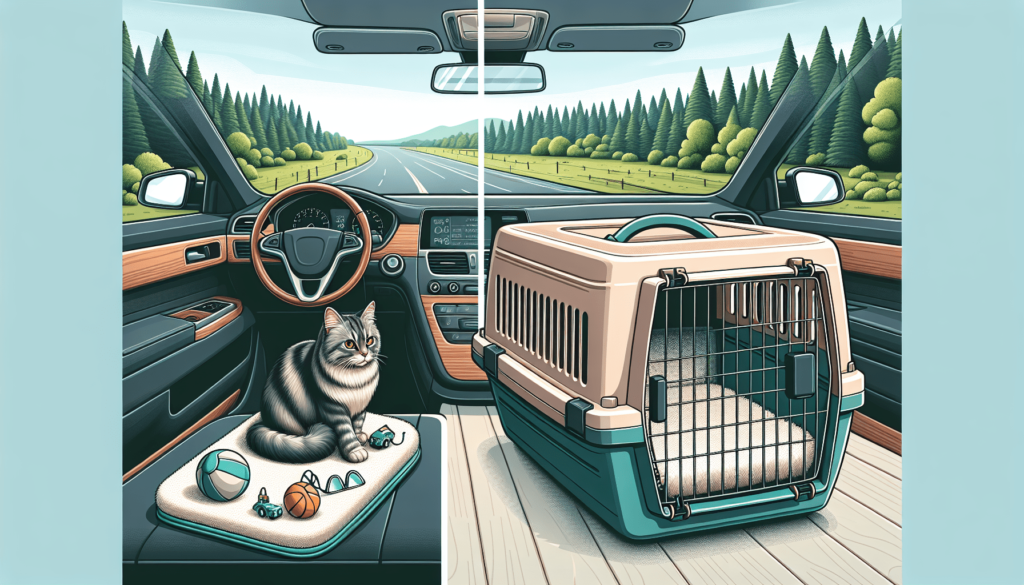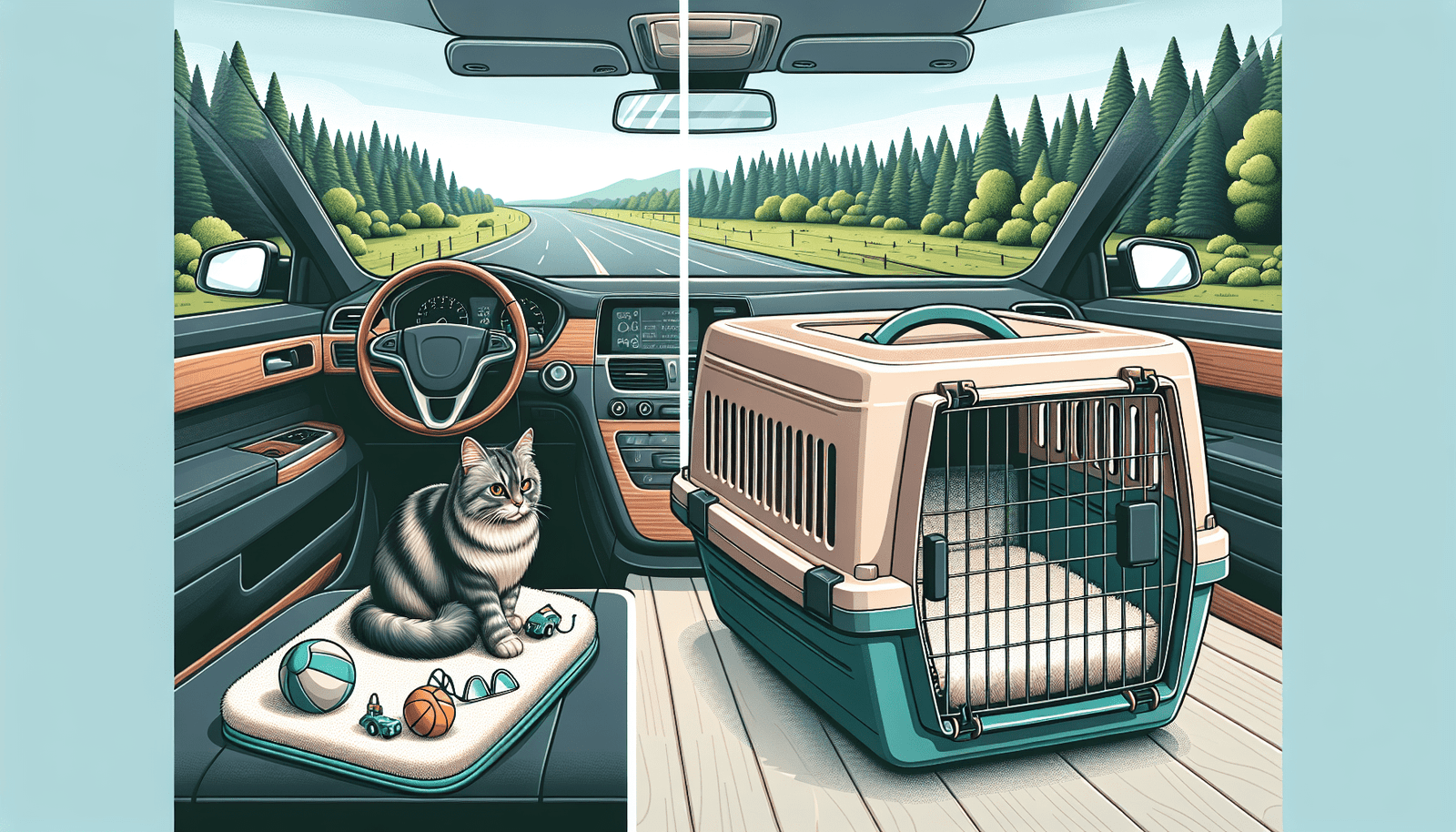Traveling with your feline friend can be a daunting task, but fear not! In this article, we will provide you with valuable tips and advice on how to ensure stress-free trips with your cat. Whether you’re planning a short road trip or a longer journey, these practical tips will help you create a comfortable and safe environment for your beloved pet. From preparing the essentials to familiarizing your cat with its carrier, we’ve got you covered. So, get ready to embark on new adventures with your furry companion without any worries or anxiety.

Choosing the Right Travel Carrier
When it comes to traveling with your cat, choosing the right carrier is crucial. Consider the size and type of carrier that would be most suitable for your feline friend. The carrier should be large enough for your cat to comfortably turn around and lie down in, but not so big that they feel insecure or unsafe.
Additionally, ensure that the carrier has proper ventilation to allow for proper airflow. This is important to keep your cat comfortable and prevent them from overheating during the journey. Visibility is also key, as cats generally feel more at ease when they can see their surroundings. Look for a carrier that has plenty of windows or mesh panels to provide your cat with a view of the world outside.
Lastly, choose a carrier that is easy to clean. Accidents can happen during travel, and you want to be able to quickly and easily clean up any messes. Look for carriers with removable and washable pads or liners, as well as carriers made from easily wipeable materials.
Preparing Your Cat for Travel
Preparing your cat for travel involves gradually acclimating them to the idea of being in a carrier and going on trips. Start by taking short practice trips in the carrier around your home so that your cat can become familiar with the sensation of being inside it. Gradually extend the duration of these practice trips to help your cat become more comfortable and confident in the carrier.
Inside the carrier, create a comfortable and familiar space for your cat. Use bedding or blankets that have your cat’s scent on them to help provide a sense of security. Including some of their favorite toys or comfort items in the carrier can also help to reduce anxiety and make the journey more enjoyable for your cat.
To further ease your cat’s anxiety, you can try using pheromone sprays or calming aids specifically designed for cats. These products can help create a sense of calm and stability during travel.
Before embarking on your trip, it’s a good idea to schedule a visit to the vet. The vet can ensure that your cat is up-to-date on vaccinations and is in good health for travel. They can also provide you with any necessary medications or advice specific to your cat’s needs.
Packing Essential Supplies
When packing for your cat’s trip, it’s important to include all the essential supplies they will need to stay comfortable and content. Make sure to bring enough food and water for the duration of the journey, as well as some extra in case of any unexpected delays. It’s essential to stick to your cat’s regular diet to avoid any digestive issues.
Including familiar bedding or blankets in the carrier will help your cat feel more secure and at ease. The scent of home can provide comfort and reassure your cat during the journey. Additionally, bringing along some of your cat’s favorite toys or comfort items can help to keep them entertained and reduce any stress or boredom.
Don’t forget to pack any necessary medications that your cat may need during the trip, as well as their vaccination records. It’s important to have these on hand, especially when traveling to different locations where they may be required or in case of any emergencies.
Safety Measures during Travel
During the journey, it is crucial to prioritize the safety of your cat. One important safety measure is to never open the carrier while in transit. Cats can be quick and easily escape, especially if they are feeling scared or stressed. Keeping the carrier securely closed prevents any accidents or escape attempts while on the move.
To ensure your cat’s safety in the car, it’s recommended to secure the carrier with a seatbelt or harness. This helps to prevent any sudden movements or accidents that could potentially harm your cat. Additionally, avoid leaving your cat alone in a parked vehicle, as temperatures can quickly rise or drop to dangerous levels.
Keeping your cat’s identification tags and microchips up to date is essential, especially when traveling to unfamiliar places. In case your cat does manage to escape or get lost, having proper identification can greatly increase the chances of a safe return.

Choosing Pet-Friendly Accommodations
When planning your trip, it’s essential to research and book accommodation that is pet-friendly. Not all hotels or accommodations allow pets, so it’s important to check beforehand. Look for hotels that specifically advertise themselves as pet-friendly to ensure a hassle-free stay.
When booking your accommodation, make sure to inquire about any pet fees or restrictions that may be in place. Some hotels may require an additional fee for bringing a pet, while others may have size or breed restrictions. It’s always best to double-check so that you can plan accordingly.
Consider the size of the room and whether it will provide enough space for your cat’s needs. Cats like having their own territory, so having enough room to move around comfortably can help reduce stress. Look for accommodations that offer designated pet areas or access to outdoor spaces where your cat can explore and stretch their legs.
To help your cat feel more at ease in a new environment, try to maintain their routine as much as possible. Stick to their regular feeding and play schedule, as this can provide a sense of familiarity and comfort during the trip.
Managing Anxiety and Stress
Traveling can be a stressful experience for cats, but there are several ways to help manage their anxiety and reduce stress. Stick to your cat’s regular feeding and play schedule as closely as possible, as this can provide a sense of normalcy and comfort.
Creating a comfortable and familiar environment in the hotel room can also help alleviate anxiety. Bring along some of your cat’s bedding or familiar items from home to help create a sense of security. Placing these items in a quiet area of the room can provide a safe space for your cat to retreat to when they need a break.
Interactive toys or puzzles can be a great way to keep your cat engaged and mentally stimulated during the trip. They can help distract your cat from any stress or anxiety they may be experiencing and provide them with an outlet for their natural instincts.
If your cat experiences severe anxiety during travel, consider consulting with your veterinarian. They may be able to recommend natural remedies or prescribe anxiety medication to help keep your cat calm and comfortable.
Ensuring Health and Hygiene
To ensure your cat’s health and hygiene during travel, it’s important to keep up to date on vaccinations. This is especially crucial when traveling to different locations where your cat may be exposed to new diseases or environments. Make sure your cat is properly vaccinated and protected before embarking on your trip.
Bringing along flea and tick prevention products is also essential, as these pests can be found in various environments. Apply the necessary preventative treatments to protect your cat from flea and tick infestations during the journey.
Maintaining proper hygiene is important for your cat’s comfort and wellbeing. Clean the carrier regularly, especially if there are any accidents or spills. Keeping the carrier clean and odor-free can help reduce any stress or aversion your cat may have towards it.
Be mindful of potential allergens in new environments. Some cats may have allergies to certain plants, pollen, or even cleaning products used in hotels. If you notice any signs of allergies, such as excessive itching or sneezing, it’s best to provide your cat with a safe and allergen-free space.
Exploring Outdoor Spaces Safely
If you plan on allowing your cat to explore outdoor spaces during your trip, it’s important to do so safely. Ensure that your cat is wearing a secure and comfortable harness that they cannot easily slip out of. A harness provides better control and prevents your cat from running off.
When exploring outdoor areas, choose designated and safe spaces where cats are allowed. This might include fenced-in areas or cat-friendly parks. Supervise your cat at all times to ensure their safety and to prevent them from getting into any dangerous situations.
Avoid exposing your cat to potential dangers or hazards. Keep them away from busy roads, toxic plants, or areas where other animals may pose a threat. It’s better to err on the side of caution and keep your cat in safe, controlled environments during your travels.
Monitoring Your Cat’s Behavior
Throughout the journey, it’s important to closely monitor your cat’s behavior and appetite. Any changes in behavior, such as excessive meowing, hiding, or aggression, could be signs of stress or discomfort. Monitor their appetite to ensure they are eating and drinking normally.
Offer reassurance and comfort to your cat in new surroundings. Spend time with them, provide affection, and engage in activities that they enjoy. This can help alleviate any anxiety they may be feeling and reassure them that they are safe.
If you notice any concerning behavior or if your cat appears unwell, it’s important to seek veterinary attention. A vet can provide a thorough examination and address any potential health issues that may have arisen during the trip.
Provide a quiet and calm space for your cat to retreat to, especially if they seem overwhelmed or overstimulated. Having a sanctuary where they can relax and decompress can greatly contribute to their overall wellbeing during and after the journey.
Returning Home After the Trip
When returning home after your trip, it’s important to keep your cat’s routine consistent. Cats thrive on routine and familiarity, so try to reintroduce their regular feeding and play schedule as soon as possible. This helps them readjust to their normal routine and reduces any potential stress or anxiety associated with returning home.
Allow your cat to readjust gradually to their familiar environment. They may need some time to explore and reacquaint themselves with their territory. Provide plenty of love and attention to let them know they were missed and to help them feel secure and reassured.
Keep an eye out for any post-travel health issues or discomfort. Changes in behavior, appetite, or litter box habits should be monitored closely. If you notice anything concerning, don’t hesitate to reach out to your veterinarian for guidance and advice.
Lastly, provide plenty of love and attention to your cat. They may have missed you during the trip, and spending quality time with them can help strengthen the bond between you. Enjoy the post-travel reunion and cherish the memories created during your stress-free trip with your beloved feline companion.

